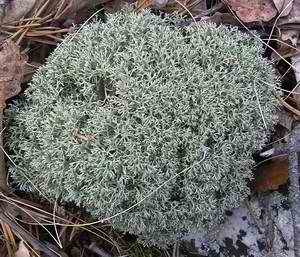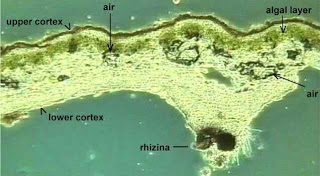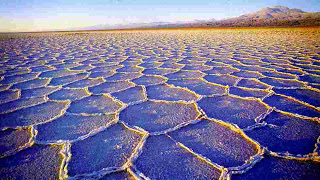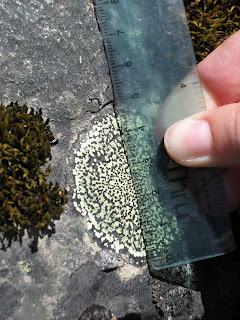Biology
The mycobiont is the more flexible of the two components; literally thousands of different fungi can act as the mycobiont. On the other hand, only 100 or so different photobionts exist. Most common of these are of the species Trebouxia. They are green algae which rarely live on their own, they have become specialized for symbiotic life as a lichen.
Fontaneto, D., Bunnefeld, N., & Westberg, M. (2012). Long-Term Survival of Microscopic Animals Under Desiccation Is Not So Long Astrobiology, 12 (9), 863-869 DOI: 10.1089/ast.2012.0828
For more information or classroom activities on lichens, exobiology, or lichenometry, see:
- Angiocarpous
Term: angiocarpousLiterally meaning: ?fruit in vessel?Origin: Anc Greek??????/aggio (=vessel, receptacle) > ?????/aggos(=tube)??????/carpos(=fruit, grain)Coined/History(?)DefinitionAngiocapous is the fruit partially or wholly enclosed in a shell,...
- Thallus
Term: thallus (pl thalli) Origin: Anc Greek ??????/thallos(=young shoot) > ?????/threpho(=feed)Definition:Thallus is the undifferentiated tissue of some algae, fungus, and other lower organisms as liverworts and lichens which are not organized...
- More Than The Sum Of Its Parts
Biology concepts ? symbiosis, lichen products, weathering, pedogenesis During the Depression, the Civilian Conservation Corps got the idea to have unemployed people earn some money by planting kudzu vine in the South to reduce erosion. It seemed like...
- Water, Water Everywhere, But?.
Biology concepts ? symbiosis, mutualism, water storage ?Gobi? means desert in Ural-Altaic,so when you say, ?Gobi Desert,? youare really being redundant.Sometimes the places with the most water are the most lifeless areas. Everyone thinks of sand and...
- When Amazing Isn?t Enough- Sea Slug Hybrids, Part 2
As you undoubtedly remember, last time we talked about a fascinating exception in biology, an animal that can perform photosynthesis. The sea slug, Eylsia chlorotica, eats algae and places the intact, functional chloroplasts in its tissues by a process...
Biology
I?m Likin? The Lichen
Biology Concepts ? symbiosis, mutualism, lichens
 |
The lycan is a subject better relegated a cryptozoology blog. Along with the Loch Ness Monster, vampires, and the Easter Bunny, cryptids are those animals for whom there is little or no solid evidence, yet the search for them by some devotees continues. |
A current movie craze has been to replace werewolves with lycans, animals that can control there physical changes to wolf, and can survive under difficult conditions. I know of another organism that has even greater powers, but wouldn?t make a great movie monster ? they don?t move and are very slow growing.
Lichens (not lycans) are some of the most intriguing species on Earth, and may very well be the most amazing organisms off Earth as well. Lichens don?t necessarily break a lot of biological rules; they just refuse to acknowledge that our rules apply to them. They write their own rulebook, and humans can?t come close to playing by their rules. They make us look like such wimps. In lichen gym class, we wouldn?t be picked last - we wouldn?t picked at all.
Lichens are symbiots of two completely unrelated organisms; one is the mycobiont, which is always a fungus. The other component is the photobiont, and can be either a green algae or a cyanobacteria. The fungal partner of the lichen makes up about 80% of the mass, but the algae or bacterial component is photosynthetic. Therefore, when they become a mutualistic symbiot, the mycobiont provides a structure and a foothold to a surface, while the photobiont supplies energy through photosynthesis.
 |
Lichens provide food for many animals. For instance, the Cladina Stellaris grows in the desolate Arctic. It provides food for the resident reindeer, who we know from past posts can disconnect its biological clock and feed all through the day. The reindeer must be particular though, because it will take the reindeer lichen decades to recover from grazing, since it grows only 3-5 mm each year. |
This is the first exception when dealing with lichens ? what are they? They certainly aren?t plants, since they contain a fungal element and not plant element. But they aren?t fungi, since they also contain a bacterial (the cyanobacteria) or protist element (the algae). They are kings in search of a kingdom. Just like Lady Gaga, they defy classification as normal life!
Fungi are decomposers; they break down organic materials to produce nutrients and carbohydrates. But in the lichen, the photobiont produces glucose by photosynthesis, so there is no need for the fungi to decompose for energy. The lichen stores most of its soluble carbohydrate as sugar alcohols, which are made by the fungal component from the algae/cyanobacteria-produced glucose. Therefore, the fungus provides a carbohydrate storage mechanism as well as a structure. These aspects give lichens the ability to live where neither the fungus nor the algae could live on its own.
The second amazing aspect of the lichen symbiosis is that the lichen doesn?t look like either the fungus or the algae that makes it up. It also doesn?t look like a mix of the two. The lichen creates a whole new morphology, with the photobiont housed below a layer of the modified fungus. In the case of lichens, you add 2 + 2 and get a Chevy.
The thallus is the body of the lichen (latin for ?green shoot?). In most cases, the thallus is a layer of the fungus, called a cortex, with the photobiont house just below the cortical layer. Enough light still reaches the algae or cyanobacteria in order to make photosynthesis possible. Below the photobiont layer is the medulla, and can include a stringy (hyphal) fungus layer or maybe just the gelatinous photobiont. Finally, some lichens will have a lower cortex layer of fungus as well. The take home message is that neither the fungus nor the algae or cyanobacteria take on any of these forms UNLESS they are part of a lichen ? it is a completely different structure.
 |
Not every lichen has a lower cortex layer, but almost all have the top cortical layer of tough fungal material. This layer protects the lichen from predation and dessication (it does nether spectacularly well). The photobiont lives primarily in the subcortical symbiont layer, while the medulla is spongy and has many fungal filaments. The rhizine connects the lichen to its substrate, but many lichens are erhizinate, they do not have rhizines. |
The combination of these two components yields the over 17,000 different lichens that have been identified. The combinations are also flexible, a lichen may use different photobionts during its life, and identical lichen types may use different photobionts even within the same general area.
The combinations of decomposer and autotroph that make up lichens are hearty and diverse. Fully 8% of the Earth?s surface is covered with lichens, not bad for something so small. More amazing is that lichens can survive in places that support almost no other life. Lichens and endolithic bacteria are only living things in the McMurdo Dry Valleys of Antarctica, as well as the Atacama desert of Chile, often called the two driest places on Earth (I think they forgot about Lynchburg, TN).
The McMurdo Valleys (4,800 sq. km) are a cold desert environment (Water, Water, Everywhere). They are almost ice and snow free, even though they are on the frozen continent of Antarctica. Less than 200 mm (8 in) of precipitation is available each year, and most of this is from summer glacier melt.
 |
The Atacama Desert in Chile is a desolate wasteland, no offense to any inhabitants. It probably has its nice parts too. Parts of the desert have had no recorded rainfall..... ever. This leads to some interesting formations, like these geometric salt patterns, very appropriate for this series of posts. |
The average rainfall in the entire Atacama Desert is even less, only about 1mm (0.04 in) per year, and many weather stations have never recorded any precipitation at all. The lichens survive on the water vapor that reaches them from the coastal fog,which comes from 150 km (80 miles) and a mountain range away. Interestingly, an extreme Antarctic cold front brought 80 cm (31.5 in) of snow to the plateau in July of 2011! This was enough to bring wildflowers to the Atacama, in places they had never been seen before.
Despite (or perhaps because of) these arid environments, lichens are the major form of life in the Atacama Desert and McMurdo Valleys. Most organisms cannot survive a loss of 20% moisture, but lichens can do just fine when 90% dehydrated. While their growth may be retarded, they quickly make up for it by absorbing up to 35x their mass in water when it is available. Lichens dry out slowly because of the dense cortex of fungus on the outside, so they can still photosynthesize despite long arid periods.
Even more exceptional, the lichen symbiot is less than 50% water, even on a good day. Mushrooms are 92% water, and algae or bacteria are typically 96% water, but when you put them together as a lichen, their normal water content is some 40-45% lower. This is how the lichen can live in places that would not support either of its components on their own ? amazing.
The deserts, both cold and hot, allow the lichens to show off another of their skills. Lichens can withstand extreme temperatures and wild swings in temperature. Scientists keep thinking up new ways to torture them. Lichens survived a bath in liquid nitrogen at -195 ?C. Not satisfied that they had been treated harshly enough, European Space Agency scientists strapped some lichens to a rocket and exposed them to the cold and radiation of outer space for 14.6 days. Cold, hot (shielded re-entry), vacuum, UV, cosmic rays ? the lichens survived just fine. Because of this will to live, exobiologists (scientists who study what life on other planets might be like) study lichens as a model alien life form or as an organism with which we might seed other planets.
Lichens (or something similar to them) are likely to be found on other planets, but they also may affect other forms of life off Earth. A recent study by performed in Italy and the UK has shown that the few animal types (rotifers, nematodes) that are able to survive dessication as lichens can are influenced greatly by their environment. They may have different ways to survive drought, but statistical modeling shows that the type of lichen they are found in has more to do with their survival in drought or even in space than their own tolerance mechanisms.
 |
Lichenometry is the art and science of investigating how long a surface has been exposed. For example, moraines are gatherings of stones at the edges of glaciers. How long has it been since the glacier receded from that spot? Lichens grow at a predictable rate given a known environment, so measuring the size of a lichen will give good estimate of how long the surface has been available to be lichenized (just made up that word). |
As a result of the poor environments where lichens can be found (although they also grow just fine in temperate areas- just look outside your front door), lichens are the slowest growing life forms on Earth. Usnea sphacelata, which looks like a small forest of bonsai, grows about 0.01-1 mm per year. Usnea can only grow on about 120 days per year, but they live a very long time. An age of 200 years is not unusual, the record is about 4500 years.
In a defined area with a defined weather pattern, lichens may grow at a very slow rate, but it is a very consistent rate. This predictability makes them good for dating other structures, a process called lichenometry. For instance, lichens can be use to estimate how long a rock face has been exposed by a retreating glacier. Once the rock is uncovered, lichens will soon colonize it and grow at a consistent rate. Once you know the size of the lichen, identify the type of lichen, and know its growth rate for that area, an age for the exposure can be calculated.
Next week we will talk more about the amazing properties and abilities of lichens, but one last tidbit for today. For anyone who has read Peter Rabbit or Benjamin Bunny to their child, Beatrix Potter is a familiar name. Before becoming a famous author, Beatrix made a living by illustrating other author?s books and doing some scientific illustrations. She was an outdoorsy girl, and her pictures of lichens led her to study them on her own.
 |
Beatrix Potter wrote more than 20 childrens classics; the illustrations were her own and are perhaps more iconic than her prose. But she started out working on lichens, and was a devout ?Schwendenerist,? a follower of Simon Schwendener?s idea of lichen symbiosis. I got the chance to collaborate with one of Simon?s distant relatives a few years ago. Hi Reto! |
While the dual hypothesis of lichens had already been put forth by Simon Schwendener, it was not well received in England. Potter used microscopy and her drawings to generate evidence for Schwendener?s hypothesis. However, she was not a scientist, and worse, she was a woman ? so she couldn't present her evidence to the botanists of her time. Her uncle was Sir Henry Roscoe, the eminent scientist who developed the first flashbulbs for photography (along with another scientist named Bunsen ? name sound familiar?). He supported her and read her papers into the scientific record, but she could never make name for herself as a scientist in that environment, so she turned to writing. It was a lucky thing for us all ? a world without Flopsy and Mopsy is too horrible to imagine.
Fontaneto, D., Bunnefeld, N., & Westberg, M. (2012). Long-Term Survival of Microscopic Animals Under Desiccation Is Not So Long Astrobiology, 12 (9), 863-869 DOI: 10.1089/ast.2012.0828
For more information or classroom activities on lichens, exobiology, or lichenometry, see:
Lichens -
http://www.lichen.com/biology.html
http://www.ucmp.berkeley.edu/fungi/lichens/lichens.html
http://www.backyardnature.net/lichens.htm
http://www.earthlife.net/lichens/intro.html
http://herbarium.usu.edu/fungi/funfacts/lichens.htm
http://www.countrysideinfo.co.uk/fungi/lichens.htm
http://www.concord.org/~btinker/gaiamatters/investigations/lichens/classactivities.html
http://serc.carleton.edu/sp/mnstep/activities/19759.html
http://gis.nacse.org/lichenair/?page=lessons
http://www.concord.org/~btinker/gaiamatters/investigations/lichens/trip.html
Exobiology ?
http://www.chem.duke.edu/~jds/cruise_chem/Exobiology/
http://www.astrobiology.com/exobiology.html
http://cmex.ihmc.us/sitecat/sitecat2/exobiolo.htm
http://adsabs.harvard.edu/abs/2007AsBio...7..443S
http://www.theregister.co.uk/2005/11/09/lichens_space_mars/
http://www.oasi.org.uk/Archive/Misc/Exobiology.htm
Lichenometry ?
http://www-staff.lboro.ac.uk/~gydjg2/baffin/3_lichen.htm
http://www.eric.ed.gov/ERICWebPortal/search/detailmini.jsp?_nfpb=true&_&ERICExtSearch_SearchValue_0=EJ401381&ERICExtSearch_SearchType_0=no&accno=EJ401381
http://www.primaryresearch.org/stonewalls/nylund/index.php
http://www.sciencebuddies.org/science-fair-projects/project_ideas/Geo_p009.shtml
http://www.geo.arizona.edu/palynology/geos462/13lichenometry.html
http://geoggeol.wku.edu/awulff/California1/Lichenometry.html
http://rockglacier.blogspot.com/2008/10/lichenometry.html
http://historyofgeology.fieldofscience.com/2010/08/botany-for-geologists-lichenometry.html
www.geog.uvic.ca/dept2/faculty/smithd/.../06%20Geog%20477.pdf
- Angiocarpous
Term: angiocarpousLiterally meaning: ?fruit in vessel?Origin: Anc Greek??????/aggio (=vessel, receptacle) > ?????/aggos(=tube)??????/carpos(=fruit, grain)Coined/History(?)DefinitionAngiocapous is the fruit partially or wholly enclosed in a shell,...
- Thallus
Term: thallus (pl thalli) Origin: Anc Greek ??????/thallos(=young shoot) > ?????/threpho(=feed)Definition:Thallus is the undifferentiated tissue of some algae, fungus, and other lower organisms as liverworts and lichens which are not organized...
- More Than The Sum Of Its Parts
Biology concepts ? symbiosis, lichen products, weathering, pedogenesis During the Depression, the Civilian Conservation Corps got the idea to have unemployed people earn some money by planting kudzu vine in the South to reduce erosion. It seemed like...
- Water, Water Everywhere, But?.
Biology concepts ? symbiosis, mutualism, water storage ?Gobi? means desert in Ural-Altaic,so when you say, ?Gobi Desert,? youare really being redundant.Sometimes the places with the most water are the most lifeless areas. Everyone thinks of sand and...
- When Amazing Isn?t Enough- Sea Slug Hybrids, Part 2
As you undoubtedly remember, last time we talked about a fascinating exception in biology, an animal that can perform photosynthesis. The sea slug, Eylsia chlorotica, eats algae and places the intact, functional chloroplasts in its tissues by a process...
